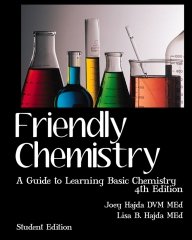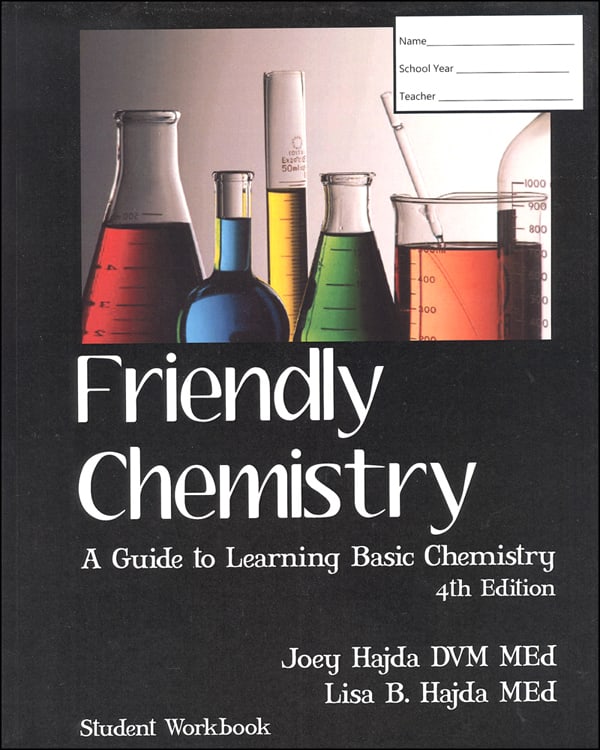Friendly Chemistry, now its fourth edition, makes Chemistry much easier to learn than most other courses on the market. A hefty book comes packaged with a manipulative booklet. that is "disassembled" to create hands-on learning tools for learning chemistry vocabulary as well as about structures, ions, forming compounds, formulas, reactions, equations, and more. The book includes fairly extensive explanations of these basic concepts plus some problems to be solved and an answer key.
Students using this course will be exposed to most of the fundamentals typically taught in a traditional high school chemistry course, but they won't cover every topic that other high school courses cover. Some students completing Friendly Chemistry will be prepared for a college-level chemistry course, but this course is best used as either preparation (possibly in junior high) for taking a more challenging chemistry course during high school or for the student who doesn't intend to study chemistry any further after high school. Consequently, while Friendly Chemistry satisfies the requirements for a high school level course, it won't be as challenging as courses such as those from BJU Press or A Beka Book.
Friendly Chemistry really is excellent for those who want to teach this course in junior high. Students can master vocabulary and basic concepts before high school which will then allow them to progress easily and quickly through a more challenging high school course, especially if they want to tackle AP exams.
The course is intended to be more manageable for more students, so the textbook isn't as dense with print as other textbooks. Students complete worksheets and hands-on activities as part of the learning process rather than the traditional course structure where students read and study the text then complete lab assignments separately. All student worksheets are included in the student text.
I mentioned that games are part of this course. Some of the games use a mixture of familiar formats such as Element Bingo, War (with the periodic table and a card deck), and a board game to work on atomic families. But some are more straightforward in requiring students to demonstrate knowledge. A certain amount of basic knowledge which is covered in the book is essential before students can even play the games. So you should use them as reinforcement/drill/practice tools to be used along with instruction. However, the hands-on, visual approach to learning that takes place with some of the games and activities will certainly make it easier for many students to grasp concepts, particularly valence structures.
The two-volume Teacher Edition features complete lesson plans as well as the student text material. Lab activity instructions and teaching tips make this course easy for the parent/teacher without a chemistry background to teach the course. The student text is written so clearly that many students could study independently, but the games and interaction are such important elements that you should plan for student-teacher interaction at a minimum, and ideally for a once or twice a week group class.
Labs use household items and other resources that are generally easy to obtain. It does not use most of the chemicals usually included in high school chemistry courses; the most "dangerous" chemicals are likely iodine solution, Epsom salts, baking soda, and, ammonia. Likewise, the equipment required includes items such as a kitchen scale, candy thermometer, narrow-mouthed jar, plastic aquarium tubing, cork, piece of rain guttering, and steel wool—maybe unusual but easier to obtain and less expensive than traditional lab equipment.
Students read the text, complete worksheets, participate in games (i.e., card games, board games, and active play-type games), labs, and activities, and conclude each lesson with a test.
This course should actually be fun for students, especially when the fun is "shared," so I would encourage you to try to gather at least a couple of students for some sort of group class.














